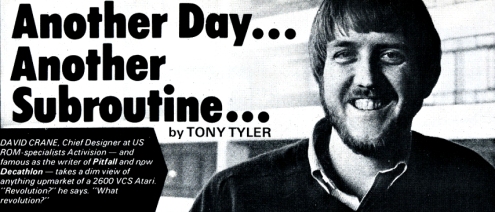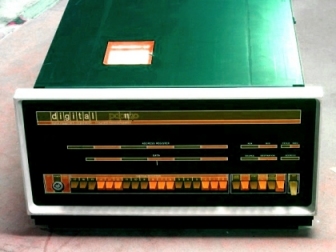- Home
- Programmers
- David Crane
- Another Day... Another Subroutine...
Another Day... Another Subroutine...
- By Tony Tyler
- Published 09/2/2006
- David Crane
- Unrated
 When you formed Activision, to what extent did you find yourselves prisoners creatively of the machine to which you pitched your earlier games - the Atari 2600 VCS which, although the definitive dedicated video game machine, is by any consent limited technically and architecturally? |
|
|
The limitations have always been the fun part. The 2600 has limitations as do all machines. But this hardware, which has a very simple architecture, requires the most of its software! Differences between games were and are almost entirely a function of the software - which was and is removable. Therefore at the time you mention this was the most versatile machine of all. It still can play the widest range of games. I can't say that we've only just scratched the surface, even now, but there's lots of things that I can do right now that I've not done before and I'm sure that there's just as many that I won't think of until I think of them! |
 Atari 2600 VCS (video game console) |
|
Do you think that the first game machine and computer designers made a mistake in opting so heavily for the expensive ROM-cart format rather than cassette? Considering that it's widely held that the commitment to the ROM-cart games machine has been said to have held back the personal computer revolution in the USA? There's certainly been an over production of ROM cartridges. The problem was the high profit margin, drawing lots of companies in - we knew at the time they didn't have the qualifications. What we didn't forsee was that every time an operation goes out of business it sells off its inventory! That's where the US ROM cartridge glut has come from. As for the idea that the installed video game base was holding back the computer revolution - well, I kind of chuckle. First of all, no-one really has a use for a personal computer and non-one can think of one. And the manufacturers can't think of one to tell them! Right now a home computer is nothing more than a video game machine with a keyboard. And until someone does come up with a real use for a home computer, there is no revolution. |
|
 Digital Electric PDP-11 minicomputer |
Could you describe for us the actual process that leads to the conception and design of a game such as Pitfall or Decathlon? From beginning to end. Well, I might start by simply staring out the window wondering what kind of game i'd like to play. 20 percent of the time I might actually see an incident that give me an idea. But if i'm designing a sports games, the rules - like for Decathlon - are already defined, and the problem is how to achieve those effects in that sequence. I then sit down with a piece of paper and draw the screens that will do the job. And obviously I do the drawing knowing what the hardware itself can and can't do. Once I get it down on paper I go right to the machine. What we have is a Digital Electric PDP-11, a relatively large minicomputer which communicates with half a dozen different workstations - we timeshare. This give me a place to keep my sourcefile. It allows me to edit the file and put it into assembly language. |
|
Do you identify beforehand those screen or routines which are likely to give you the most trouble and go for them first? Or do you write sequentially, taking the problems as they come? I start with the harder bits. It's difficult on a machine - that was never intended to display more than balls and paddles and maybe a couple of tanks shotting at each other - to make it handle, say, a running man. So the first thing I had was a couple of legs running across the screen with no body attached. You pull that off very smoothly in both Pitfall and Decathlon. How many frames are there in the moving legs sequence? You could say ten frames. You could also think of it as twenty frames! And the shadow? That was fun. To get the shadow to stay on the ground and not rise with the man when he jumps was one of the early problems. But in general you could say I program in small modules. I write a certain routine and make sure it works before I go on to anything else. I have an overall picture in my mind as to what I'm going to need. I always like to design one routine an have it working perfectly before the end of the day before I go on to the next one. So a subroutine roughly equals one days work? I don't like to go home with an unwritten program hanging over my head. That's me. Now Alan Miller (Activision colleague), he'll sit in a rocking chair for three days writing the program - he writes most of it at that time. Comes into work, types it in, pages and pages, turns it on and sees what happens. I can understand that but its not the way I work. You think in assembly language? Probably easier than English. |
|
|
What gave you the idea for Pitfall? I started Decathlon before Pitfall. I had the running man OK, but then I realised that at that time I would not be able to do a ten-event Decathlon justice. So I shelved it. Then I did Pitfall. I had to get the running man idea out of my system. OK, there he is, running across the screen. What next? He goes to another screen. What now? So I might as well put him on a path. Jungles have paths - better throw in a few trees - always bearing in mind that I'd want to be able to do this for other machines. Basically, if you can do it on the VCS, you can do at least a shadow of it on the other systems. So anyway, what use is a jungle path unless it leads somewhere? So I pencilled in a few objects. How about some places to fall? A few holes. he's got to land somewhere - I had to put in an underground level. Then I spent the next two months defining the game, saying wher do I put the treasure, what kind of monsters lurk? Scorpions look pretty good. I thought I might have ghosts and skeletons in the tunnel - none of them looked good, so they didn't get in. We drew a lot of these beforehand on squared paper, colouring them in and so on. But it never looks the same on the screen as it does on paper - never. |
 Decathlon (Atari 2600 VCS) by Activision |
|
Finally, I might spend six months on a program just doing things that you would hardly be able to tell weren't there before. It's that which people notice - even subliminally. Bug-freeness. Freedom from bugs. The last 10 per cent of the game takes ninety per cent of the time. Article reproduced from Big K magazine April 1984 edition. Although all text appears unchanged, some photographs or images have been added or modified for aesthetic purposes. Thank you to the following websites which were used for sourcing some images that appear in this article: Atari Age, Ebay, Obstetric Ultrasound |
|
Spread The Word
Article Series
This article is part 2 of a 3 part series. Other articles in this series are shown below:
-
Another Day... Another Subroutine...



